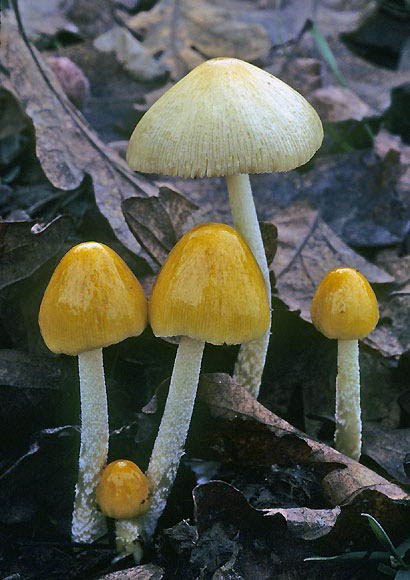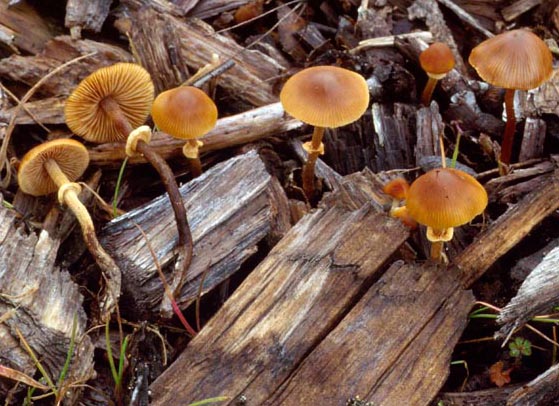

© Kit Scates Barnhart and Steve Trudell
Danny’s DNA Discoveries – Bolbitiaceae of the PNW
by Danny Miller
Click here for my Pictorial Key to Bolbitius, Conocybe and Pholiotina
|
|
Danny’s DNA Discoveries – Bolbitiaceae of the PNW
Click here for my Pictorial Key to Bolbitius, Conocybe and Pholiotina |
|
Introduction
This family is made up of "Little Brown Mushrooms" with a cellular cap cuticle (fragile little things where the cap can break in any direction and tends to glisten and wrinkle, as explained in more detail in the Introduction on my Psathyrella page). The spore print can often be a light, bright cinnamon brown. They are often conehead shaped, in fact, Conocybe literally means "cone head". There only used to be two genera in this family known from the PNW, Bolbitius and Conocybe, with all Conocybes thought to be deadly poisonous, until genetic evidence showed that Conocybe needed to be split into four genera: Conocybe, Pholiotina and two previously unnamed genera. Pholiotina s.s. contains species with deadly amatoxins, the principle toxins in the death cap, Amanita phalloides. Some Conocybes, like C. alpala, contain a less concerning phallotoxin (which they say is not absorbed through the stomach). The previously unnamed genera are not really studied yet so we don't know their edibility, and Bolbitius seems to be non-toxic. Bolbitius are viscid, pretty little yellow or lilac mushrooms (rarely other colours too). They are all mostly urban mushrooms, growing in grass, gardens, straw, wood chips, dung and maybe rotting wood. All other genera in this family are boring little brown mushrooms with dry caps. Conocybe can be told by the presence of capitate cheilocystidia. They look like bowling pins. Pholiotina s.s. can be told by the presence of a ring, or usually at least a partial veil. Conocybula are not ringed nor do they have partial veils. They will not have bowling pin shaped capitate cheilocystidia like Conocybe (but they may be somewhat rounded). Some turn blue at the base. If they don't, they will be difficult to separate from Conobolbitina. Conobolbitina are similar to Conocybula but never turn blue. A good paper on how this family is arranged, by Toth, can be found here. This is from before the two unnamed genera were named. abundant common uncommon rare - colour codes match my Pictorial Key and are my opinions and probably reflect my bias of living in W WA. Rare species may be locally common in certain places at certain times. |
|
Summary of Interesting Results
Here are some of the newest, most interesting results of the study:
|
 Bolbitius - click to expand Bolbitius - click to expand
Viscid, yellow or sometimes lilac LBMs, usually more colourful than the other genera in the family, which are dry capped and will at most be white or golden brown. Any of the species can wrinkle or become reticulated. Rarely, red, orange or green colours are found. Species mentioned: Bolbitius titubans, vitellinus, titubans var. olivaceus, variicolor, reticulatus, aleuriatus |
 Conocybe - click to expand Conocybe - click to expand
Little brown dry capped coneheads without a ring (nor any kind of partial veil). Some Pholiotina s.l. may not have a ring, so microscopically, Conocybe can be told by capitate cystidia (sterile cells on the gills with prominent round heads). Species that turn blue are probably not Conocybe, but ringless Conocybula. At least some Conocybes contain phallotoxins, not as concerning as amatoxins, but still to be avoided. Species mentioned: Conocybe alpala, lactea, aurea, tenera, coniferarum, rickenii, fuscimarginata, pubescens, semiglobata, fibrillosipes, brunnea, michiganensis, hausknechtii, pallidospora |
 Pholiotina - click to expand Pholiotina - click to expand
Pholiotina s.s. are usually ringed little brown mushrooms (or less commonly, the partial veil leaves veil material on the cap margin). Rings are rare on small brown spored mushrooms, and for some reason usually indicate "deadly amatoxin poisons", as in the case of Pholiotina as well as the Galerina marginata group. Species mentioned: Pholiotina filaris, rugosa, gracilenta, utricystidiata, flexipes, pinguis, fimicola, stercoraria. |
 Conocybula - click to expand Conocybula - click to expand
Conocybula - unless white stemmed and subtly bluing, they must be separated microscopically from Conocybe, and are difficult to separate at all from Conobolbitina. Species mentioned: Conocybula cyanopus, smithii, aberrans, coprophila |
 Conobolbitina - click to expand Conobolbitina - click to expand
Conobolbitina - must be separated microscopically from Conocybe and is difficult to separate from non-bluing species of Conocybula at all. |